Linguine Pesto Pasta - Linguine Al Pesto

Take an old favourite to a new level with this linguine pesto pasta (or Linguine Al Pesto as they say in Italy). With al dente linguine (or another pasta shape of your choice) tossed in super fresh and vibrantly flavourful homemade pesto, this recipe is packed with tips and tricks to ensure you achieve pesto perfection.
Ready in just 15 minutes, there is never a bad time to rustle up this superbly tasty pasta dish.
Want to add some protein? Try my Tuna Pesto Pasta. There's also this Sun-dried Tomato Red Pesto Pasta. Or you can use the homemade basil pesto in this Lasagne Al Pesto.
The post contains additional information and helpful tips to ensure the recipe turns out great the first time. Please use the link above to jump to the recipe card at the end if you are in a hurry!
- Indescribably fresh, flavourful and delicious.
- Super easy 15-minute recipe.
- Make your own basil pesto or use store-bought to save time.
- Adaptable.
- Make-ahead and freezer friendly.
Homemade pesto:
- Basil leaves: The fresher the better.
- Pine nuts: Toasted to bring out their flavour.
- Olive oil: The amount might seem like a lot but it's needed to bring the pesto to the right consistency.
- Parmesan: I recommend grating your own rather than using pre-shredded.
- Garlic powder: Optional and adds a touch of umami flavour without the bitter taste of raw fresh garlic.
- Lemon juice: For a touch of citrusy freshness.
Other ingredients:
- Pasta: This comes down to personal preference. I like to serve basil pesto with long varieties of pasta like linguine and spaghetti but you can also go for shorter pasta shapes like fusilli, rigatoni or penne.
- Pasta cooking water: Make sure you reserve a cup of starchy pasta water before draining. You can add it to the pesto linguine to bring the pesto sauce to the desired consistency.
- Basil - substitute with other blendable leafy greens like spinach, kale or arugula/rocket.
- Pine nuts: switch for cashews, walnuts, almonds or Pistachios.
- Parmesan: swap for another hard cheese like Pecorino or Grana Padano or use nutritional yeast for a vegan alternative.
- Garlic powder: You can use a fresh garlic clove. I recommended crushing it and frying for a minute or two in olive oil first to get rid of the bitterness.
Note that the recipe has not been tested with the substitutions and the variations below, so the results cannot be guaranteed.
- Swap the basil for other leafy greens to make spinach pesto, rocket pesto or kale pesto.
- Switch the pine nuts for pistachios to make pistachio pesto
- Serve the pasta with my Red Sun-dried Tomato Pesto instead of green basil pesto
- Add chicken, shrimp or try my Tuna Pesto Pasta for extra protein
*Be sure to see the recipe card below for the full ingredients list & instructions! *
Step 1: Place a pan on a medium to high heat and toast the pine nuts for a few minutes until golden.
Step 2: Add the basil leaves, Parmesan, garlic powder (if using), and lemon juice and blitz.
Step 3: Slowly pour in the olive oil and continue to blend until the pesto reaches the desired consistency.
- Food processor. For fast and convenient blending. A mini food processor can come in handy if you are making a small batch.
- A hand blender is also fast and efficient, good for small batches and is easier to wash up than a food processor.
- Pestle and mortar. Some will say that a pestle mortar is the right way to go if you're after ultimate flavour and texture. This will take longer and require some elbow grease.
Step 4: Drain the cooked pasta, ensuring you reserve a little pasta water first and place it into a clean pan or bowl. Toss in the pesto, adding reserved pasta water a little at a time until it reaches the desired consistency. Serve immediately topped with optional extra Parmesan and pine nuts
You can serve this dish as a main meal or side to enjoy with chicken or fish like this Panko Baked Cod.
Linguine al pesto goes nicely with a refreshing side salad like my Strawberry & Rocket Salad or Blue cheese, apple, grape and walnut salad.
Basil pesto and pasta are great together, but it certainly isn't the only way to enjoy green pesto. You can use it to make Lasagne Al Pesto, Pesto Crusted Salmon, serve with gnocchi, or use as a sandwich spread.
- Keep an eye on the pine nuts. They can go from nicely brown to burnt very quickly.
- Reserve some pasta water to pour on the cooked pasta pesto to bring it to the correct consistency.
- Mix the pasta in a new bowl or pan rather than the pan you cooked the pasta in. Keeping the pesto cool helps to preserve its vibrant flavours. Keeping the pesto cool helps to preserve its vibrant flavours.
Several factors can dull the flavour of pesto, including insufficient seasoning, low-quality ingredients, overheating or prolonged exposure to air. The absence of an acidic component, like lemon juice, may also contribute to a lack of brightness in the taste.
Why does pesto turn brown?When exposed to air, pesto's vibrant green colour can turn brown due to a chemical reaction called enzymatic browning. This occurs when enzymes in the basil leaves react with oxygen, causing the chlorophyll pigments to break down. Acidic ingredients, such as lemon juice or vinegar, can help slow down this process.
Can you use the basil stems to make pesto?While basil stems are edible and contain some flavour, they are generally not used as the primary ingredient in pesto. The stems can be tough and fibrous, which may result in a less desirable texture. It is best to use just the tender basil leaves.
What does al pesto mean?"Al pesto" is an Italian phrase that translates to "with pesto" in English. It is often used to describe dishes that are prepared or served with pesto sauce.
What's the best way to store pesto?Pesto can be stored in an airtight container in the refrigerator for up to a week and frozen for up to 3 months. In both cases, it's advisable to cover the surface with a thin layer of olive oil to prevent browning.
Easy Lasagne Al Pesto
Pesto Crusted Salmon
Tuna Pesto Pasta
Sun-dried Tomato Red Pesto Pasta (pesto rosso)
Did you try this recipe?
Linguine Pesto Pasta - Linguine Al Pesto
Recipe details
Ingredients
Pasta
- ▢ 400 g (14 oz) Linguine pasta (Note 1)
- ▢ 120 ( 1/2 cup) pasta cooking water (Note 2)
Homemade basil pesto (see note 3 if you wish to use store bought pesto)
- ▢ 3 tbsp pine nuts + extra to serve (Note 4)
- ▢ 60 g (1 cup) basil leaves (Note 5)
- ▢ 30 g ( 1/3 cup) finely grated parmesan + extra to serve (Note 6)
- ▢ 1/4 tsp garlic powder (optional) (Note 7)
- ▢ 1/4 tsp salt
- ▢ 4 tsp lemon juice
- ▢ 120 ml ( 1/2 cup) olive oil (Note 8)
Instructions
- Cook the pasta according to packet instructions in generously salted boiling water.
- Place a pan on medium to high heat and toast the pine nuts. Remove them from the pan and set aside as soon as they turn brown.
- Add the basil leaves, parmesan, garlic powder (if using), and lemon juice to a food processor and blitz.
- Slowly pour in the olive oil and continue to blend.
- Drain the cooked pasta, ensuring you reserve the pasta water first.
- Place the pasta into a new pan or bowl, add the pesto and toss together, adding a little pasta water until the pesto reaches the desired consistency, then serve immediately topped with optional additional Parmesan and toasted pine nuts. (Note 8)
Tips
- Pasta shape: This comes down to personal preference. I personally like long pasta shapes like linguine or spaghetti with pesto, but feel free to choose the shape you fancy.
- Pasta cooking water: Make sure you reserve a cup of starchy pasta water before draining. You can add it to the cooked pesto linguine to get the pesto saucy and juicy.
- Store-bought pesto: You can use 50-60g or ¼ cup of store-bought pesto per person instead of homemade pesto.
- Pine nuts: Substitute with cashews, walnuts, almonds or Pistachios
- Basil leaves: Substitute with other blendable leafy greens like spinach, kale or arugula/rocket.
- Parmesan: Swap for another hard cheese like Pecorino or Grana Padano or use nutritional yeast for a vegan alternative.
- Optional garlic powder: You can use a fresh garlic clove. I recommend crushing and frying for a minute or two in olive oil first to get rid of the bitterness.
- Olive oil: The amount might seem like a lot, but it's needed to bring the pesto to the right consistency.
- Combining pasta and pesto: It is important to mix the pasta in a new bowl or pan rather than the pan you cooked the pasta in. Keeping the pesto cool helps to preserve its vibrant flavours.
- Storage:
- Pesto can be stored in an airtight container in the refrigerator for up to a week and frozen for up to 3 months. In both cases, it's advisable to cover the surface with a thin layer of olive oil to prevent browning.




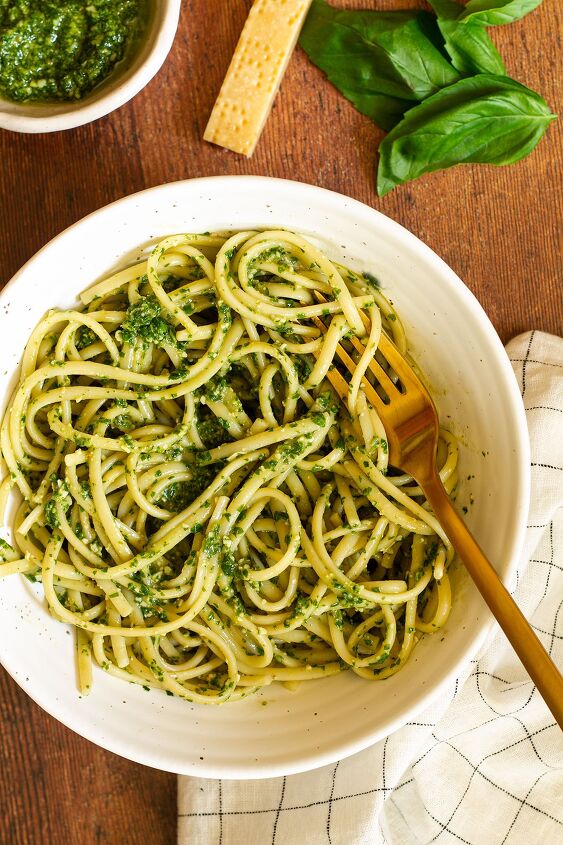












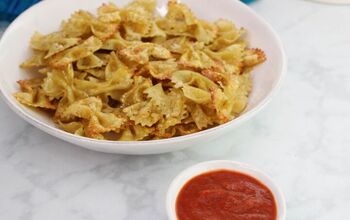



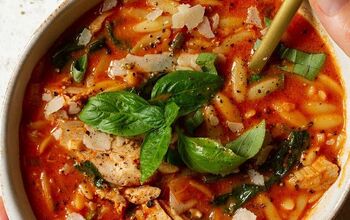
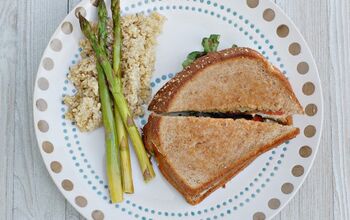




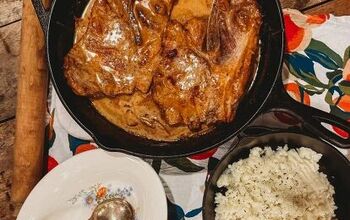




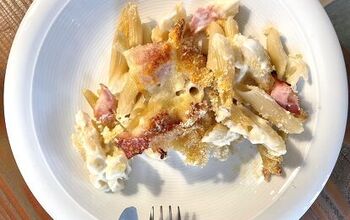
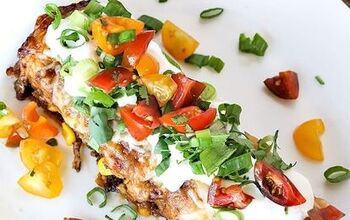
Comments
Share your thoughts, or ask a question!